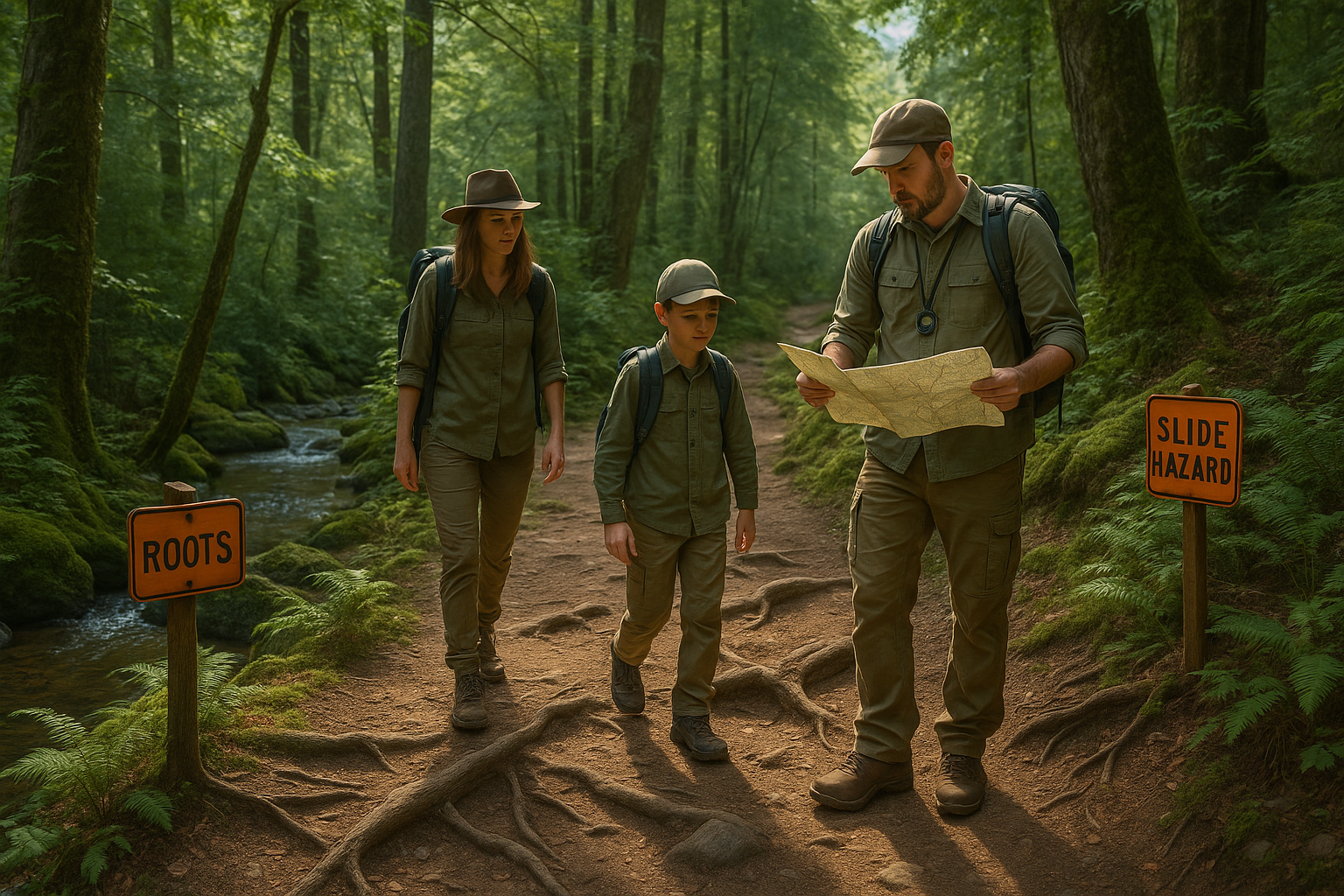It’s a world of vast, open spaces, alluring trails, and the promise of heart-stopping adventure. But as the old adage goes, “with great power comes great responsibility,” and in this case, the responsibility lies in ensuring personal safety while navigating these trails. In the wilderness, seemingly innocent environments can pose unexpected hazards. Therefore, having a clear understanding of these risks and knowing how to avoid them is paramount. This article is an essential guide to help you do just that: Navigate with Caution: Avoiding Trail Hazards and Staying Safe in the Great Outdoors.🌲
Over the next three thousand words, we will delve into the common pitfalls that adventurers often face, arm you with actionable steps to handle each one, and ultimately, ensure that your outdoor experience is as safe as it is exhilarating. So, whether you’re a seasoned hiker, a weekend wanderer, or someone who’s just started to venture beyond the city limits, this comprehensive guide is for you. 🌄
Understanding the Risks
While the rewards of exploring the great outdoors are many, it’s important to understand that this awe-inspiring beauty comes with certain risks. The first section of this article will acquaint you with these potential hazards, ranging from challenging terrains and unpredictable weather to encounters with wildlife. Knowing what could go wrong is the first step in avoiding mishaps.🔎
Preparing for the Journey
Any successful expedition starts with meticulous preparation. Here, we will explore the crucial factors that need your attention before you set foot on the trail. We’ll discuss the importance of physical preparedness, choosing the right gear, and understanding trail etiquette. Also, we’ll delve into the role of technology in enhancing safety during outdoor adventures, an often overlooked aspect by many hikers.⌚️🎒
Navigating the Terrain
Once you’re on the trail, navigation is key. We’ll guide you through the skills required to navigate different types of terrain, from dense forests and rocky mountains to serene beachfronts and arid deserts. We’ll also discuss how to identify and handle dangerous situations, including landslides, flash floods, and getting lost. 🏞️
Dealing with Wildlife
Wildlife encounters can be awe-inspiring, but they can also pose serious dangers. This section will provide useful insights on how to handle potential encounters with wildlife, highlighting how to identify signs of wildlife presence, how to react if you come face-to-face with a wild animal, and the importance of respecting the wildlife. 🐾
First Aid and Emergency Situations
Despite our best efforts, emergencies can happen. In this crucial section, we’ll explore essential first-aid skills that every adventurer should know. This information could be the difference between life and death in critical situations. Plus, we’ll discuss effective emergency communication strategies and the importance of a well-stocked survival kit. 🆘
By the end of this guide, we hope to equip you with the knowledge and skills needed to safely enjoy the thrill of exploring the great outdoors. The adventure awaits; let’s ensure it’s a safe one. 🏔️
🏞️ Navigating the Outdoors: The Joy and the Peril
With its crystal-clear rivers, towering mountains, and sweeping vistas, the great outdoors offers an incredible range of experiences. The bliss of a quiet forest, the thrill of a challenging mountain climb, the serenity of a peaceful river – each of these experiences is unique and unforgettable. However, along with the thrill and serenity comes potential danger. Nature, while breathtakingly beautiful, is also immensely powerful and unpredictable. In this article, we delve into some of the most common trail hazards and provide you with essential tips to stay safe while navigating the great outdoors.
From understanding weather patterns to recognizing dangerous wildlife, outdoor safety requires a blend of knowledge, preparedness, and respect for nature. Let’s unpack some of the most common outdoor hazards and learn how to tackle them effectively.
Remember, information is the first step towards preparedness. Arm yourself with the right knowledge, and your outdoor adventures will be both safe and rewarding. Let’s get started!
🌩️ Weather Woes: Predicting and Preparing for Nature’s Moods
The weather plays a critical role in outdoor adventures. A sunny day can turn a difficult hike into a pleasant walk; conversely, unexpected rain can turn a simple trail into a treacherous pathway. Hence, understanding weather patterns and preparing for possible changes is vital for any outdoor enthusiast.
Start by checking the weather forecast for your destination. Note down the temperature, precipitation, and wind speed. If the weather seems unpredictable, it’s wise to postpone your trip or choose a less risky trail. However, keep in mind that weather forecasts are not always accurate, especially for remote areas. Therefore, it’s essential to prepare for various weather conditions.
Watch “How to read a weather map” by Met Office – Learn About Weather on YouTube for an in-depth understanding of weather patterns.
🐍 Wildlife Encounters: Recognizing and Responding to Danger
Encountering wildlife is one of the most exhilarating aspects of outdoor adventures. However, not all wildlife encounters are safe. Certain animals, like bears, snakes, and mountain lions, can pose significant threats to humans. Knowing how to recognize and respond to these dangerous animals is crucial for outdoor safety.
Research the wildlife in your destination area. Learn about their behavior, signs of presence, and recommended safety measures. For example, if you’re hiking in bear country, you should know how to use bear spray, and understand bear behavior to prevent an encounter in the first place.
For a detailed guide on wildlife safety, watch “Staying Safe Around Wildlife” by Parks Canada on YouTube.
🌿 Plant Perils: Identifying and Avoiding Harmful Flora
Nature isn’t just about majestic creatures and stunning landscapes. It’s also home to countless plant species, some of which can be harmful to humans. Poison ivy, poison oak, and poison sumac are common examples of toxic plants that can cause severe allergic reactions.
Before venturing into the wild, familiarize yourself with the harmful plants in your destination area. Learn how to identify them and what to do if you come into contact with them. Always wear long pants and long-sleeved shirts to protect your skin from potential exposure.
Watch “How to identify Poison Ivy, Oak, and Sumac” by Dr. Pimple Popper University on YouTube for a practical guide on identifying these toxic plants.
🚶 Navigational Challenges: Mastering Map Reading and Compass Skills
Navigating through the wilderness can be challenging, especially in remote areas with minimal signage. A detailed map and a reliable compass are invaluable tools for any outdoor adventurer. However, these tools are only useful if you know how to use them.
Map reading and compass skills are essential for navigating unfamiliar terrain. They can help you determine your location, plan your route, and stay on track. These skills can also help you find your way back to safety if you lose your way.
Watch “Learn to Navigate with Map and Compass” by REI on YouTube for a comprehensive tutorial on navigation skills.
🔥 Fire Safety: Building and Extinguishing Fires Responsibly
Fires can provide warmth, light, and a way to cook food in the wilderness. However, they can also cause devastating forest fires if not handled properly. Hence, fire safety is a critical aspect of outdoor adventures.
Before starting a fire, ensure it’s permitted in your area and that conditions are safe. Never leave a fire unattended, and always extinguish it thoroughly before leaving the site. Keep a bucket of water or a fire extinguisher handy, and know how to use it.
For a practical guide on fire safety, watch “How to Safely Make a Campfire” by REI on YouTube.
As you venture into the great outdoors, remember the importance of safety and preparedness. Knowledge, respect for nature, and careful planning can make your adventure both exciting and safe. Stay informed, stay prepared, and let the beauty of nature inspire and invigorate you.

Conclusion
In conclusion, we have delved deep into the complex and intricate world of IT and software engineering. We explored the nuances, the methodologies, and the technologies that form the bedrock of this continually evolving domain. From the concepts of cloud computing and Big Data to the principles of Agile and DevOps, we have covered a wide range of topics to offer you a comprehensive understanding of the field.
One of the key takeaways from our discussion is the indispensable role of IT and software engineering in driving business growth and innovation. In the age of digital transformation, businesses can no longer afford to ignore the strategic potential of technology. It’s not just about automating processes and reducing costs; it’s about creating value, enhancing customer experience, and staying ahead in the competitive landscape.
We also underscored the importance of adopting a proactive approach to cybersecurity, emphasizing the need for businesses to invest in robust security measures to protect their data and digital assets. With the rise in cyber threats and data breaches, cybersecurity is no longer an option; it’s a necessity.
In the realm of software development, we underscored the importance of Agile and DevOps. These methodologies, with their emphasis on collaboration, continuous delivery, and customer feedback, are reshaping the way software is designed, developed, and delivered. They are not just methodologies; they represent a cultural shift, a new way of thinking and working.
As complex as these topics may seem, we strived to explain them in a simple, understandable manner, using real-world examples and case studies. We hope that this approach has helped you grasp the underlying concepts and appreciate their practical implications.
We encourage you to delve deeper into each of these areas, using the resources we have provided throughout the article. IBM’s Cloud Learning Center, ScienceDirect’s Big Data Topic Page, and Atlassian’s Agile Resource Center are excellent starting points.
We would love to hear your thoughts on the topics we covered. Feel free to share your comments, questions, or insights. Did you find the article informative? Do you have any practical tips or best practices to share? How are you applying these concepts in your work or business? Let’s keep the conversation going. 😊
Remember, in the fast-paced world of IT and software engineering, learning is a never-ending journey. So, keep exploring, keep experimenting, and keep growing. 💻🚀🌐
Finally, if you found this article useful, please share it with your colleagues, friends, or anyone who might benefit from it. Knowledge is power, but it becomes even more powerful when it’s shared. Let’s spread the knowledge and empower others. 🙌
#KeepLearning #KeepSharing #IT #SoftwareEngineering #CloudComputing #BigData #Agile #DevOps #Cybersecurity



